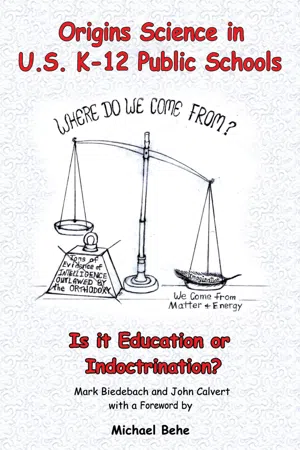
Origins Science in U.S. K-12 Public Schools; Is it Education or Indoctrination?
- 226 pages
- English
- ePUB (mobile friendly)
- Available on iOS & Android
Origins Science in U.S. K-12 Public Schools; Is it Education or Indoctrination?
About This Book
A Biophysicist and Constitutional Lawyer Address a Profound Question. Is it OK for our public schools to teach only Atheistic answers to ultimate religious questions?Where do we come from and what is the nature of life? These are the two biggies implicitly addressed by U.S. K-12 origins science education. The answers form the foundation for the third: How should life be lived ethically and morally? The answers to the third will be significantly affected by how we answer the first two. The authors show that there are two evidence-based alternatives to the first two. We either come from unguided material causes without purpose or we come from material and intelligent causes for a purpose. The materialistic alternative provides the foundation for non-theistic religious answers to questions of ethics and morality, while the teleological alternative supports theistic answers. The problem is that modern origins science uses a concealed materialistic orthodoxy that permits only Atheistic narratives about the origin of the Universe, of life and the diversity of life. Thus, when these materialistic/atheistic explanations are taught by our K-12 public schools, the impressionable kids are only given an atheistic narrative rather than an objective education about the evidence for and against both views. Calvert, the lawyer who switched from stock fraud to Constitutional law 20 years ago, explains how the law actually favors the objective rather than the materialistic method for origins science education. Atheism is just as religious as theism for First Amendment purposes. Accordingly, just as the schools cannot push a theistic prayer during the invocation at a high school graduation, neither can it adopt or implement an atheistic orthodoxy when teaching origins science. He also explains that objectivity is also required as the scientific method for the testing of historical narratives require consideration of all evidence-based alternatives. At the end, the Authors provide a set of ten suggestions for the development of objective standards and curricula for teaching origins science.
Frequently asked questions
Information
Table of contents
- Foreword
- Part I
- Part II
- Part III